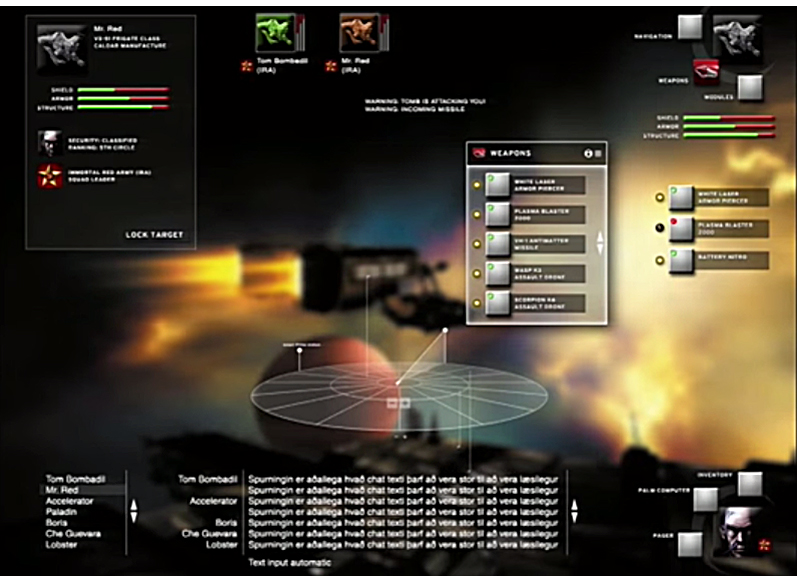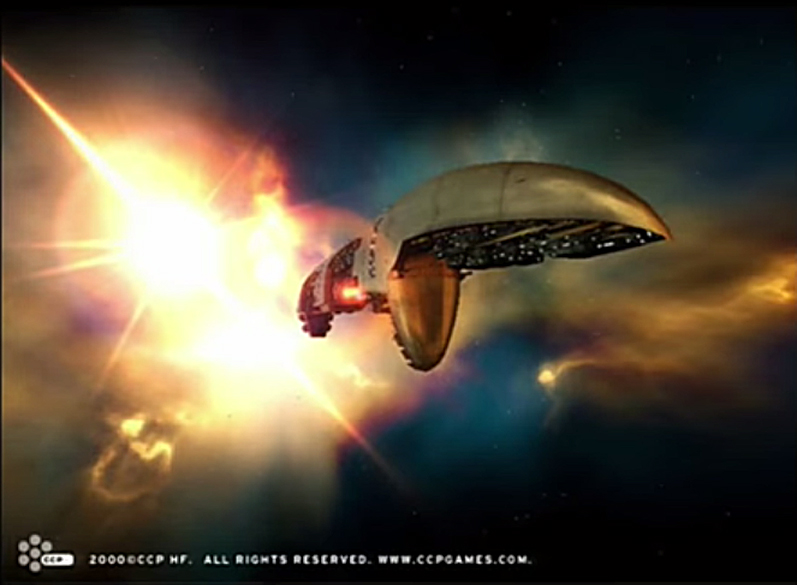There is no shortage of opinions, some informed, on what will happen after June’s sov mechanic’s arrive. Most of it over-reaches as there are no few specifics on the mechanics to really nail any scenario down. Still, the honest attempts to foresee where the game ends up are a sign in and of themselves: The nature of EVE as a game, and our relationship to it, is going to change.
The first MMOs started to appear 15 to 25 years ago, depending on what you consider “Massively.” The first networked game with graphics, a cooperative first person shooter in a maze, was created in a lab in 1974. But the first generation of MMOs played over the internet, were created in the early to mid 1990s, as the modems become household items. Initially, the first MMOs cost a whopping $12 per hour, and were essentially chat channels with live nightly events governed by game masters. AS the novelty wore off and the technology improved, the availability of the online games increased and their prices began to fall.
EVE was conceived by CCP in 1997, based on these first generation of MMOs. It finally launched in 2003, along with other MMOs creating a new second generation of titles. This new breed of online games hit the market by storm and enjoyed great popularity world-wide for several years. Players were drawn to persistent virtual worlds, where they could exist through an avatar.
The Mission
Create the most complex massively multiplayer universe ever



EVE’s first existence, programmed by Hilmar (current CEO of CCP), evolved over a few years until it was released in 2003 as the second generation of MMOs being released. The above photos depict the initial gameplay model with a local chat, and the first concept for UI, and below, renders of the early ship designs. Note the ate is 2000. EVE hit the market at the right time as home computers and development software were rapidly improving, allowing games to be higher quality.
May 2003 saw the release of Eve Online …Eve was able to achieve lasting success. One of the reasons for its success may have been the game’s design, in which all subscribers play in one shared universe… – Wikipedia
The second generation of MMOs thrived through 2010, but industry projections of being the “next best thing” were off, and they soon started to stagger and collapse. The combination of aggressive subscription models (No subscription, free to play), and competition from social-mobile games, and an aging playerbase worked against the online games. They also regularly failed to meet the expectations they promised and were plagued with bugs or frustrating gameplay.
EVE had those same problems, but it was able to keep moral high by refreshing their visuals and sound, reducing downtime, and managing game performance. They were also immune to demoralizing affect of server merges, since players were already one one shard.
EVE benefited from lowered expectations. CCP was a complete unknown, and EVE was a niche game: A competitive sandbox, with ownership possibilities. That great combination of allowing anyone wishing to live free and cut a piece of space out for themselves was attractive and unique. For the ambitious, the single shard meant influence and reputation were magnified: Whatever mark one made, was a universal, single point of reference for everyone else that played. The legendary complication of the game served as a protective barrier, keeping out whimsical players. EVE was serious business.
From the start, one of the most attractive facets of any MMO was the persistent world. Influencing that world had an even greater appeal. Game creators have always known this, creating high scores list, leader boards, and other mechanisms that allowed players to register their achievements. In EVE’s case, the goal for many was to put your name on the map, literally. Players grouped into corporations and alliances, to work together toward a common goal: Conquer and hold sovereignty over the lawless outer rim of space, null-sec.
The above map is from a few months after EVE was launched. The drone regions were as unreachable as Polaris or Jovian space, and null-sec was an extension of low-sec, and disconnected from other null-sec regions. In 2003, a null-sec alliance could “guard the gates” to effectively protect their territory. The Delve-Quarious area was the original “Not Red Don’t Shoot” (NRDS), protected by Coalition of Free Stars. It didn’t last long though, to shake things up CCP connected null-sec to each in 2004, as pictured below.
In 2005, outposts (stations) and dreadnoughts were introduced. Sov mechanics at this time were updated to a hidden point system based on tower ownership, weighted by sizes or towers, in system. If you owned the majority towers in a system, it belonged to you. This, at a time when it took 60 minutes to put up a tower and the same to bring it down if you had to evacuate. Each tower module took 20-15 minutes, thus to build a defended tower, with guns and defenses, took hours, and even then a tower could not claim sov until it was in place for 5 days.
Wars were slow, intimidating, and fought moon-to-moon with giant HP based objectives, which were handled by dreadnoughts and battleship fleets. Carriers, Motherships (later renamed to super-carriers) and Titans were also introduced in 2005. The Motherships/Titans could host “Rebirth facilities” (cloning vats) and large ship maintenance bays to support Rapid Fleet Deployment operations. In addition they could inflict massive damage, through drones and fighters, and for the Titan, a devestating, 250,000km area of effect Doomsday device. Sov war was ultimately a massive endevour, perfected by dedicated logistics capable alliances.
By the end of 2006, CCP opened the drone regions, which were later named with the help of EVE players. By them, guarding entry gates to null-sec regions evolved into holding key stations that an alliance could project power from. The map below is from March 2007.
By 2008, Null-sec had to be revamped because players exhausted from “ping-pong” sov wars, where one timezone would clear and replace 20 towers, go to sleep, and wake up to those gains reversed because the enemies did the same thing in their timezone.
The huge tug-of-war mechanics were changed in 2009, in the Dominion expansion. These are the current mechanics found in EVE today, and decoupled system ownership from towers completely and created special structures instead: Territorial Claim Units, were to be deployed in each system to claim it. These mechanics still requires large HP objectives to be completed, usually by the ever-increasing capital ships.
CCP had created a spectacular game with few players able to pilot massive ships that other players could rally around. All the trappings of massive fleet battles that are depicted in EVE trailers like Dominion [video] or Prophecy [video] were available for players to if they wished to use them as intended. Unfortunately, players never adapted to using Titans or supercarriers as mobile stations, and center pieces to diverse fleets. Instead Titans were used as bridges, and the players flew themselves to the engagements from their staging systems. The jump clone timers and the hassle of remembering to redepositing a clone was probably too much for pilots to track. Players appears to just want to fight and win by using the most effective means possible.
Titans were also as killing machines as they could Doomsday through cyno portals and wipe out fleets without ever being at risk. That was fixed quickly by CCP, but alliances had mastered the shipyards and were efficiently producing the massive ships. Multiple Titans would double-doomsday fleets, so anything smaller than battleship fleets were a risk: Battleship doctrines were popular, partially to avoid being wiped out instantly.
This 2007-2009 era was a great time to be a rare super capital pilot. Capital pilots were coveted and devastating over subcapitals. Titan’s were rare and when one was killed it was a true newsworthy event, unlike today. The first Titan was killed in May 2007 by Shrike and the Band of Brothers, followed closely by his own Titan being downed soon after in June 2007, by Goonswarm. Note the cultural differences in Fleet comms:
Note: Shrike (SirMolle), the Titan Pilot, incidentally is the same pilot that fought for the house of Sarum in the Amarr Succession Trials, and the leader of the most intimidating alliance in EVE, Band of Brothers. Goonswarm’s killing this Titan would be equivalent to Brave Newbies taking out an entire Pandemic Legion (PL) capital fleet. Shrike is still active, leading the venerable corporation Evolution (home for TarPalantir I, who authored this opinion piece recently.
The breaking point for Sov happened at the end of the Second Great War, when PL, Goonswarm, and allies lined up 25 Titans to cerebrate their victory with a display of power: They doomsdayed a carrier with only 16 of the 25 Titans, and put a Dreadnought in deep structure, which meant they could destroy multiple fleets of any class for an area of 250,000km, except other supers. The writing was on the wall, and the Titans were quickly nerfed, making the doomsday device a single target weapon, but plans to move the goal post even further were needed.
Null-sec fell into terrible stagnation as players created a stable money making structure: Renting space to other players. This eventually formed into a few super-power coalitions that did not war each other because there was no longer an incentive to do so. Note, in this time lapse video it – just how diverse the evolution of null-sec was for years, until 2014, when it freezes. Two major antecedents were the formation of OTEC and the B0tlord Accords.
CCP was not ready to fix sov but pressure to change made them have to act. They took action and nerfed a pilot’s ability travel with jump drives and jump gates. This was to restrain pilots from travelling across the map in capital ships in just minutes. The urgent measure limited power projection, but did not change the nature of sov warfare. Big ships, and lots of pilots to fly them, was still the winning combination.
From the beginning, CCP made the most complex MMO ever, and the players put in the time and effort to learn how to play it. There was a kind of contract there, that if you played a long time you would fly massive ships that dwarfed the masses that joined after you did. It was a pyramid scheme. Players agree to wait their turn while they prepared to make their mark too. But the newly proposed sov mechanics are pulling the plug on that contract, and forming a new one. The new sov mechanics and more changes to follow are eliminating high HP objectives, which eliminated the career path of most null-sec players.These are welcomed changes by players that like to play EVE, especially as a skirmish pvp platform. It also lowers the barrier of entry for newer players, which rings unfair to those that waited.
Not all players actually have time to play EVE. The demographics are skewed to older players (see demographics chart) that have stuck with the game for years. As EVE players age the enter new phases of RL: Career building, children, second jobs, etc. Many sov players can still make EVE work for them by only loggin in after getting a ping for a CTA, and since getting all the “cats herded” takes time, a prepared player can basically be semi afk a fleet. Add fleet warp, regroup, “lock it forget it” structure grinds, and you have a single FC doing all the work. You may notice in half of an allaince fleet is totally quiet, while the other half, those with time, are shitting up comms.
For the carebear types, local chat and standings are a combo that creates a radar that alerts you are in possible danger so they can manage other internet duties as they mine or rat.
That is a second social contract between CCP and players: If you put your time into learning how things are done, and spend time and money skilling up to be able to do them, there is a way to be in EVE without having to “man the controls”. This might be essential as players get older and RL takes over. Not everyone can FC or fly booster ships, or scout when RL can yank them out of the game. No one wants to let down their team-mates when that happens. This is why being able to play EVE solo or semi-afk is essential, even if that means you do logistics for an alliance, farm anoms, build ships, etc. All those activities help hold sov.
In retrospect, CCP built a buffet of complex mechanics over a futuristic landscape that appealed to players who want to make their mark. MMOs, in general, and EVE specifically, allow a player to exist, and even gain recognition from other players in an enclosed community. This engages our highly evolved sense of place in a pack. The brain chemicals lit by discovery, belonging, achievement and gambling are triggered by EVE which is part of the reason it is so damn addictive.
The nature of EVE is well suited to gain loyal players too, which allowed it to buck trends and succeed. There was a contract for progression: Put in your time, even while offline, and you will be rewarded. RL could be first, and your place in line could still be held through real-time leveling mechanics. That contract is expiring in June, but fear not, a new contract is taking its place: Log in at your scheduled time, have some pvp fun, see you tomorrow. If all goes well, EVE’s null-sec should turn into a giant Red vs Blue landscape, with objectives to complete even if you are logging in solo for a few minutes. As for having your name on the map, you’ll have to put it there and keep it there by playing the game. But that’s a different article.